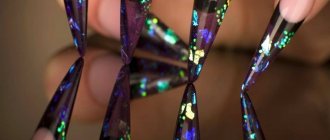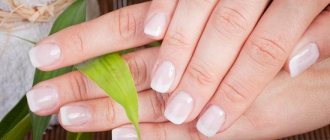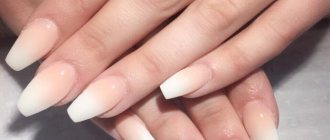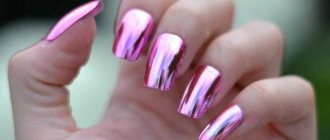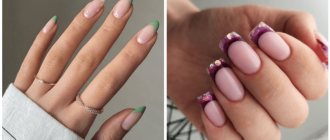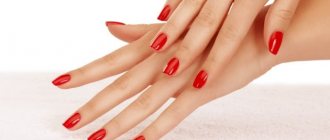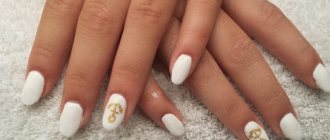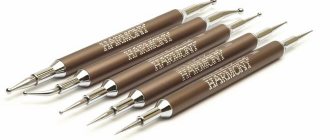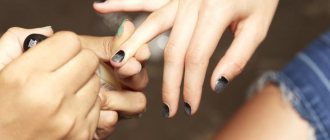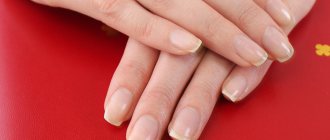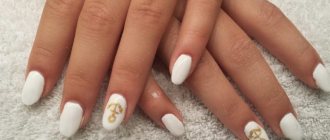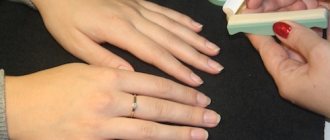Well-groomed, neat hands create a pleasant impression of a woman, emphasizing her individuality and adding elegance. With the help of beautiful nails, representatives of the fair sex can demonstrate a sense of style and excellent taste. A systematic trip to a nail salon has already become a habit for most women, because thanks to the work of the master, they not only feel confident, but also take care of their health.
Manicure is a comprehensive procedure for caring for the skin of hands and nails, consisting of their hygienic treatment and decoration with decorative products. Manicure includes the following actions:
- therapeutic strengthening baths;
- removing the old coating of the nail plate;
- cuticle treatment;
- giving nails a beautiful shape;
- massage of hands using scrubs, masks, moisturizing creams;
- formation of the nail bed, its opening;
- removal of rough skin;
- nail extensions;
- coating;
- decorating nails with special elements (rhinestones, foil, thermal film).
Most often, manicure refers to the direct treatment of nails, but the procedure also involves tidying up the skin around them. The hygienic component of care allows you to avoid problems such as:
- hangnails;
- cracks;
- fragility and thinness of the plates;
- dryness;
- splitting of nails;
- ingrowth, etc.
In relation to the cuticle, there are two types of manicure:
- Trimming (classic) is one of the most popular methods provided in any nail salon. When performing it, a bath is used to soften the skin of the hands and a set of metal tools. With their help, using mechanical movements, the master removes cuticles, removes the keratinized layer of epithelium from the skin ridges and lengthens the nail bed. Trimming manicure is considered the most unsafe, since during the procedure it is easy to touch nerve endings, damage capillaries, and cause infection through small cuts.
- Untrimmed (European) is a safe option for processing cuticles that does not involve their removal. The master applies modern cosmetic products to the skin, softening and “absorbing” the cuticles. After some time, using an orange stick, they move away or peel off, depending on the degree of hardness. After such treatment, the growth of the cuticle slows down, and with each new application of the lotion it becomes softer and more pliable. However, the nails do not look as neat as after the classic procedure, and the effect does not last long.
Hygienic manicure involves carrying out restorative, moisturizing, corrective procedures that act as a preventive measure for nail problems. This type of care includes Japanese and Brazilian methods.
Japanese manicure
Its main goal is to improve the health of the nail plate and hand skin. When performing it, only materials of natural origin are used: wood, ceramics, suede, beeswax, etc. The step-by-step procedure looks like this:
- The master assesses the condition of the hands and diagnoses the disease.
- Complete disinfection is carried out.
- A mineral bath is made, then the nails and skin are treated with special lotions and serums.
- A strengthening paste is applied to the plates, which smoothes the surface, filling all the cracks.
- The cuticle is softened with oil from lotus seeds, vanilla, algae, then pushed back with an orange stick.
The main disadvantage of Japanese manicure is its high cost. Masters who master this technique are not found in every salon.
What products are needed to create a manicure coating with gel polish?
In order to create a manicure using gel polish, you will need: buff, orange stick, degreaser, primer, base, colored gel polish, finish, UV lamp or LED lamp, liquid for removing the sticky layer, lint-free wipes and cuticle oil. It is very important to carefully clean your instruments so as not to inadvertently infect yourself with any infection. In addition, all devices should be stored in a clean, not hot place.
Brazilian manicure
Brazilian nail treatments are faster than other types. It is performed with a one-time set consisting of:
- gloves already coated with the necessary leather treatment products;
- wooden stick;
- files.
The wizard acts in the following order:
- Prepares hands by removing old coating and treating skin with antiseptic.
- He takes out a file from the set and gives the nail plates the desired shape.
- Puts gloves on the client, making sure that the product inside them is distributed evenly. Leave it on for 5-7 minutes.
- Releases fingertips one at a time, gradually working the cuticles on each nail.
- He takes off his gloves and wipes off the remaining cream with a napkin.
- Massages hands and applies polish if necessary.
The Brazilian method is safe and suitable for women with sensitive skin. The product in the gloves whitens the nails and makes them stronger. However, the result will not be as pronounced as with a classic manicure.
Coverage: basic standards of the “Russian school”
It's nice to know that our mothers are considered one of the best in the world. The standards of the “Russian school” are quite high: they imply a cuticle coating, a perfectly even highlight, the same length and shape of the nails, competent architecture, careful processing of the side rollers, a relatively small thickness of the coating and maximum accuracy. Our country has also established the production of materials that are quite competitive on the world market.
Hand massage
Hand massage is the final stage of manicure. It stimulates blood circulation, relieves muscle fatigue, helps cope with stress and improves mood. There are several types of massage for hand care:
- Finger massage. The master applies the cream to the skin and gently massages the muscles of the fingers, alternately stroking and pressing on them. Then he rotates them and moves them in different directions, pulling them towards himself in turn. No operation should be painful.
- Hand massage includes strong rubbing from the fingertips to the elbow, superficial stroking on both sides of the arm, kneading the wrist with soft circular movements.
- General massage involves massaging the entire palm, working out the joints of the hand and fingers, rubbing the muscle tissue on the pads, intensively rubbing in moisturizer and lotions
SPA treatments
If the skin of your hands is dry and rough, and your nails are breaking and peeling, you should pay attention to spa care. The essence of the procedure is complete relaxation of the body. Scented candles, essential oils are used here, and soothing music is played. This manicure takes longer than a traditional one, since all actions are performed measuredly.
Spa treatments include:
- paraffin baths;
- acupressure;
- softening the cuticles with a special solution;
- removal of keratinized epithelium with a scrub;
- restorative wrap;
- vitamin masks;
- nail plate whitening;
- applying moisturizer or serum.
This type of manicure will not give a lasting effect after one visit to the master. If your nails are neglected, getting them in order can take from 5 to 10 procedures. But after going through the whole range of services, your hands will look well-groomed for much longer.
Baths for hands and nails
Baths are paraffin therapy for skin and nails, which has a therapeutic, preventive and softening effect. Nutrients and restorative substances can be added to the water depending on the problem that needs to be solved. Baths are made for:
- strengthening the nail plate;
- increased growth;
- whitening;
- getting rid of lamination;
- giving a healthy shine;
- skin healing.
There are several basics for performing paraffin therapy on hands:
- Oily. Recommended for dry hands and brittle nails that need hydration and nutrition. The oil can be special, purchased at a pharmacy, or regular olive oil. It is heated in a water bath and vitamins, salt and other components are added to it.
- Saline. This base is considered the most common, as it is easy to prepare and produces a lasting strengthening effect. There are different types of salt used, from table salt to mineral salt.
- Herbal. Baths based on hypoallergenic herbs fight skin diseases and restore the structure of the nail. The most popular decoctions for this procedure are chamomile, mint, string, dandelion and plantain.
Another type of hand skin care is a hot manicure, where you also need to dip your fingers into the bath, but there is a peculiarity here - the temperature of the treatment agent should always be kept at around 40⁰C. For this purpose, special devices are used to maintain heat. After the hot procedure, the skin becomes soft and velvety, the cuticle can be easily removed and pushed back without the use of nippers.
Types of manicure by technique
There are more than two dozen of them, and they can be grouped according to different features and intensity of care for hands, nails and cuticles. Also, many masters combine stages from different types of manicure in their work, depending on the needs of each client. For some, a dry manicure is suitable, for others, a European unedged manicure can be recommended, and for a third, a hot manicure or paraffin therapy.
Having understood the types of manicure, it will be easier for you to create a personal care program or a scheme for working with clients if you are a master.
There are the following types of manicure:
- Hardware dry
- Classic edged
- European unedged
- File manicure;
- SPA manicure
- Hot manicure
- Basic or mini manicure
- Japanese
- Brazilian
- Children's
- Deluxe
- Paraffin therapy
Hardware dry
Hardware dry manicure is recommended not only as a regular care procedure, but also for medical indications, for example, with ingrown and growing nails, after fungal diseases, and with a number of pathologies of the structure and shape of the plates.
It is characterized by speed of execution - 30-40 minutes, and safety due to the lack of contact with cutting tools. It is performed using a milling machine with different attachments for each stage of the procedure. Dry. During operation, the cutters rotate at an average speed of 3 to 30 thousand revolutions in two directions - forward and reverse, forward and back.
First, the cuticle is lifted with a ball, cone or cylinder, then the pterygium is cleaned with a needle or truncated cone, the cuticle is removed with a ball nozzle and the side ridges are processed with a cone or needle. The plate and the skin around it are polished with a silicone or fabric polisher. These are the main attachments that will be useful for beginners at the start.
Read more about hardware manicure and the main mistakes made by both masters and beginners.
Classic edged
The most popular version of the procedure using cutting instruments is scissors and tweezers. Because of this, it is also the most traumatic.
After disinfecting and shaping the nails, steam them in a bath and remove the cuticles with scissors or tweezers. Before applying varnish, be sure to use a dehydrator and degreaser to remove excess moisture.
For closely located vessels, experienced professionals recommend European or hardware manicure to avoid unnecessary injury. The trimmed option is suitable for heavily overgrown cuticles and rough side ridges, as it allows you to completely remove the excess.
Trimmed classic manicure - how to do it correctly
European unedged
It is a supporting procedure and is recommended for well-groomed or in good condition nails and cuticles. Not suitable for a starter option or in advanced cases.
The procedure involves applying a cuticle softener to the skin. Then the skin is peeled back with an orange stick, wiped with a napkin, and treated with cosmetics and care products. Safe and fast type of manicure - no contact with cutting tools.
Unedged European manicure - execution technology
Saw
A safe nail treatment technique in which the side ridges and cuticles are processed with special safe files. File manicure is considered a type of European manicure, but lately it has increasingly emerged as an independent technique.
The main advantages of file manicure include:
- Safety. The skin is not cut, so there is no risk of damaging its integrity, which is especially important for girls with closely located vessels;
- Hygiene. Since the integrity of the skin is not compromised, filing manicure is one of those techniques that minimizes the risk of infection;
- Improving cuticle quality. Regular file manicure slows down the growth of the cuticle and makes it softer.
File manicure has no contraindications.
We have already talked about how to perform a file manicure in NAILS magazine, so we will look at the step-by-step instructions very briefly:
- Processing begins with the side rollers - they are sanded with a file with short movements;
- After the rollers, the cuticle is lifted with an orange stick;
- The raised skin is also sanded with a file without the tool coming into contact with the nail.
There is no need to soak your hands or apply remover - all manipulations are carried out on dry skin.
What is a file manicure and how is it done?
Japanese
New in the nail industry. The essence of the procedure is not only to improve the appearance of the nails, but also to provide gentle care using only natural materials and natural extracts. This makes the plate harder and more elastic.
Types and technologies of Japanese manicure for nail care and treatment
The master does not use metal tools, only suede, ceramics, and wooden sticks. Cosmetics for this procedure are also called pharmaceutical products. Natural beauty and health are the highest priority aspects in Japanese manicure.
Brazilian
It is a variety of European unedged. The master uses a ready-made disposable kit, which includes an orange stick, a nail file and gloves filled with cream. The cream contains nourishing, moisturizing and regenerating components, as well as oils, calcium and keratin. Hands are placed in gloves, and after the cuticle is softened, it is removed with an orange stick.
How is a Brazilian manicure done and what is it?
SPA manicure
The procedure combines active and relaxing hand and nail care with the application of varnish and design.
The stages of implementation and the cosmetics used differ from salon to salon. The purpose of such a manicure is to restore the water balance of the skin, make it soft, rejuvenate, and eliminate dryness and brittleness of the nails. During the procedure, oils, salts, scrubs, herbs, exposure to heat and light are used. Traditionally, the procedure includes a hand bath, peeling, paraffin therapy, masks, cream application, and nail care with special products. Spa manicure can last up to 3 hours.
Types of SPA manicure, how it is done and necessary cosmetics
Paraffin therapy
It can be used in combination with a SPA manicure or can be considered as a separate care procedure to moisturize and soften the nutrition of the skin of the hands and nails. Cream or lotion is applied to the skin of the hands, then they are immersed in wax heated to 50 degrees, and placed in plastic and fabric gloves. Leave for 20-30 minutes.
You can add herbal infusion, aroma oil, extract, or fruit component to the heated wax. The combined effect of heat and wax under polyethylene and fabric gloves transforms the skin. The procedure is indicated in the off-season, for dry, tired skin, and for mild rheumatoid pain. More information about paraffin therapy can be found in the section “Paraffin therapy.
Paraffin therapy: everything you need to know about this useful procedure
Delux
It is a combination of a basic manicure with paraffin therapy and aromatherapy treatments. It is done up to the elbows and above. After disinfection, hands are immersed in the bath. This is followed by peeling to the elbows, paraffin therapy and aromatherapy masks, correction of cuticles and plates, massage and varnishing.
Basic or mini manicure
A basic or hygienic manicure is a set of procedures that must be performed at least once a month in order to maintain a healthy and well-groomed appearance of nails. It is often called a mini-manicure, which includes minimal but most important components of care - peeling, massage, correction of the shape of nails and cuticles, strengthening and nourishing the nail plate, base coat before applying varnish.
Children's
To form a beautiful nail shape, you should pay attention to your child’s manicure from childhood. The length is removed with scissors and the ends are lightly polished. Hands are immersed in a warm bath for 5-7 minutes, and then softening oil or cream is applied, the cuticle is pushed back with an orange stick, and a light massage is performed. Afterwards the coating is applied. It is not recommended to do an edged children's manicure.
Male
The main requirement is the naturalness and accuracy of the result. Instead of varnish - a transparent composition with a matte texture. The basis of care is the classic edged, hardware or European manicure options. It will take on average a quarter more time than for women due to thicker and rougher skin. This is ideal.
Men's manicure - technology and necessary tools
Men perceive the procedure rather as a necessity, and most often seek professional help in exceptional cases - before important events or after heavy loads on their hands.
Hot
A large amount of warmed cream, lotion or oil is used as a hand bath. The procedure is healthier and more effective than a spa manicure.
Indicated for very dry, cracking skin, in the off-season, with frequent contact with chemical detergents. Heals, restores, moisturizes the skin within 15-20 minutes of exposure. It is characterized by high cost.
Hot manicure - how to do it, what products are needed
Therapeutic manicure
Therapeutic manicure is prescribed for people suffering from:
- ingrown nails;
- fragility, thinness and lamination of nail plates;
- fungus;
- chapped and dry skin;
- deep cracks in the hands.
This type of care is performed by specialists with medical education according to the following algorithm:
- Cleansing the skin of hands and nails, disinfection.
- Placing hands in a bath with a composition selected based on the disease.
- Hardware nail treatment.
- Application of a health-improving coating to the plates.
- Massage.
- Skin moisturizing.
Therapeutic manicure is more expensive than a classic manicure and is not suitable for those who have wounds, purulent formations or allergic manifestations on their hands.
Nail extensions
Extensions help women quickly get long, beautifully shaped nails. The service is provided in any nail service studio; you just need to decide which way to extend your nails: using tips or forms.
For tips
Tips are artificial blanks in the form of future nails of the desired shape. They are attached to the plate using an adhesive base, dried and decorated. They are made of plastic, polyflex or nylon. The differences between materials are in their reliability, methods of adhesion, elasticity, and modeling capabilities.
Pros:
- suitable for any length of your nail;
- durable and strong;
- done quickly;
- in case of injury, the plastic template simply peels off without harming your own nail;
- large selection of shapes.
Minuses:
- nails look artificial after the procedure;
- the tip of the nail turns out to be thick, which creates inconvenience and does not look so aesthetically pleasing;
- when using low-quality materials, you can damage the structure of your nail;
- After removing the tips, the nail plate becomes thinner.
Required materials and equipment:
- tips and tip cutters;
- adhesive base;
- UV lamp;
- brushes, files, pushers, nippers, scissors;
- degreaser;
- gel thinner;
- cotton swabs;
- brush for removing dust.
On forms
The shape is a kind of backing with a small window for the nail. The master applies modeling gel to this window, which, after hardening, becomes the free edge of the plate. The form is deleted after the procedure.
Pros:
- nails look natural;
- no need to sharpen your own nail, injuring it;
- you can create any bends and shapes, change the direction of growth.
Minuses:
- The procedure requires a length of the free edge of the nail of at least 2 mm;
- if your nail is in poor condition, this type of extension will not work;
- not strong enough.
Required materials and equipment:
- manicure set (buffs, wooden stick, files, etc.);
- disposable or reusable forms;
- primer
- gel (base, modeling, finishing);
- degreaser;
- glue.
What are top forms
A relatively new extension technology assumes that the material is applied inside a transparent form, then applied and fixed on the nail, and after polymerization the form is removed.
The inconvenience of the technique is that not every shape can be modeled (for example, pipe and edge are formed on the lower ones). But this method saves a lot of time.
If there is little snow, there will be no harvest: December 16 is Ivan the Silent Day
“We are still friends”: Derevianko commented on the breakup with his wife
Rare shot: Viktoria Isakova showed her grown-up daughter from Yuri Moroz (new photo)
Nail decoration
After completing the hygienic treatment, the master begins decorating the nail plate. The method of nail decoration depends on:
- woman's personal preferences;
- nail conditions;
- master's capabilities.
Decoration can consist only of applying a base in the form of varnish, gel or shellac, or it can contain an individual design. The following are used as decoration elements:
- stencils of different shapes (hearts, stars, spirals, etc.);
- beads and rhinestones;
- special sand or sugar;
- sequins;
- melange shavings;
- voluminous carvings;
- magnetic pigment;
- sparkles, etc.
There are many types of decorative manicure:
- French manicure - medium-length nails in the shape of a soft square, covered with a base base in a natural shade: pink, beige, milky. At the tip of the plate, a “smile” is displayed in white colors. This method looks natural, aesthetically pleasing, emphasizing elegance and femininity. French is a classic, suitable for any style, but not capable of surprising.
- American manicure - long, oval-shaped nails are painted in a bright color, usually red, and match the shade of lipstick. The varnish is applied directly to the plate without pre-strengthening it.
- Manicure gel polish (Shellac) is a durable coating that allows you to consolidate the effect of well-groomed nails for up to 4 weeks. It combines the properties of varnish and gel: it remains durable without damaging the plate. First, the master applies a strengthening base, then several layers of coating, including the finishing one. Each layer must be dried under an ultraviolet lamp.
- Spanish manicure involves decorating your nails with bright colors and stripes that visually lengthen your fingers. You can use an unlimited number of colors, the main thing is that horizontal and/or vertical stripes are outlined on the plates. The Spanish method encourages non-standard combinations of shades.
- Lunar manicure is reminiscent of the French version, but instead of a “smile,” a hole stands out at the base of the nail plate. The element is displayed using a special stencil in a color that contrasts with the shade of the rest of the nail.
- Negative space or naked manicure. A transparent color base is applied to the nail, on which all kinds of decor are then painted using stencils or stickers. The main feature is that there should be more “bare” space on the nail than decorated. To prevent the coating from seeming boring, use bright colors and intricate shapes.
- “Night sky” or shiny manicure. The effect of a twinkling starry sky is created on the nails by applying sparkles, glitter, shimmer, shining minerals, and mica to them. Made in blue, violet, light blue shades.
- Ombre (gradient) is the arrangement of several colors on the nail at once, smoothly transitioning into each other. Shades can be close or contrasting, the main thing is a blurred transition between them. The gradient can be filled in both vertical and horizontal directions or diagonally.
- Glass nails or “broken glass”. Using pieces of foil and holographic film, the artist creates a pattern on a single-color nail that resembles shards of glass. Particles can be arranged either in a chaotic manner or arranged into a specific element in the form of a mosaic stained glass window, for example.
- Nude – nails of any length and shape are covered with a pastel shade of varnish, as close as possible to the color of the skin. However, they do not have to be monochromatic; they may contain a gradient, delicate subtle patterns and various decorative elements.
- Artistic, Chinese manicure. With this method of decoration, each nail plate is painted separately with an individual design, usually associated with flowers and plants. The master must have high artistic skills and know how the brush behaves on a particular surface. The design looks good only on long nails.
- Stamping is the creation of patterns on plates using silicone impressions, a kind of “stamping”. Special stamping kits are sold, with their help you can apply stripes, ornaments, flowers, honeycombs, etc. to your nails.
- Nail art is a unique art of creating an individual design on nails. The master draws ornaments, attaches rhinestones, beads, jewelry, sculpts figured patterns, etc. With high-quality work, this type of manicure looks the most luxurious.
- Extravagant designs are made to stand out from the crowd. Nails may have a non-standard shape, drawings that attract attention, “gaps” in the form of holes may form on the coating, flowers or insects the size of real representatives of flora and fauna may grow on the nails.
Types of manicure by design features and materials
Types of manicure briefly based on design features and materials used:
- French
- Art French
- American
- Spanish
- Powder
- Wedding
- Business manicure for the office
- Gel polish or gel strengthening
- Nail art
French
In a professional environment it is called “French”. It is distinguished by naturalness, elegance and versatility. Suitable for any occasion and outfit. It was invented in 1976 by the founder of the Orly brand. The main emphasis is on the white tip. The rest is painted clear, light pink or beige. For short nails, masters often use tips for French extensions. Varieties of this design include reverse French and moon manicure.
Design options for a French jacket - a selection of ideas
Art French
A branch in the direction of French manicure, where the emphasis is on a non-standard combination of colors in a contrasting or complementary range. Experiment by combining yellow with purple, black with red, blue with white. For more ideas, try using a color wheel. Decorate the ends with additional decor.
American
The nails are given an elongated oval shape. Bright, rich tones of varnish or paint are used - scarlet, crimson, cherry, burgundy. These two features distinguish this option from the rest. It is recommended to select the color to match the color of the lipstick with a difference of a maximum of 2 tones.
Spanish
A distinctive characteristic is the bright, catchy color of the varnish in combination with graphic vertical stripes. It visually corrects and lengthens the shape of short nails. The most popular option is two horizontal wide stripes of contrasting shades on one nail.
Thermal varnishes - how to choose and use
Powder, using acrylic powder
Colored, transparent, with a metallic sheen, the powder is especially popular due to its practicality in application and incomparable durability. The manicure lasts 4 weeks, does not wear off, does not lose color, and has an interesting texture. The powder comes with a gel base. After applying the foundation, your finger is dipped into the powder, dried in a UV lamp, and then the residue is brushed off with a brush. Powder is also used to further strengthen the nail plate. Can be applied in several layers.
You can make a powder design by drawing a design or pattern with gel polish or paint, dipping the nail in the powder, and then drying it in a lamp.
Acrylic nail modeling and design with colored acrylic powders
Manicure with gel polish and gel strengthening
The most durable type of manicure. The procedure uses a three-phase system - base, gel polish or gel and top coat. Nails are polished, degreased, a base is applied and dried in a UV or LED lamp. Then comes varnishing in one or two layers and drying in a lamp. The work is covered with topcoat, dried in a lamp and the top sticky layer is removed. In a manicure with gel polish, it is very important to seal the ends, so it will last almost twice as long. The results last for 2-3 weeks.
Layers of coating in manicure - what are they, how to apply them correctly
If the plates are thin and brittle, you can strengthen them with gel. They do not perform extensions; the product is applied only to natural nails. Under the gel coating, its own length grows without chipping or delamination.
Nail art
This is the decoration or painting of nails in different styles and techniques. Combine with gel or gel polish manicure, which ensures the durability of the design for several weeks. Nail art is performed using varnish, paints, art materials and textures that are popular in the nail industry from season to season.
Nail art is indispensable for a festive manicure, allowing you to create a bright, spectacular look. For every day, you can choose design styles with muted shades and graphic solutions.
Requirements for performing manicure in the salon and at home
In order for the nail care procedure to be as safe as possible, it is necessary to follow a number of rules:
- All instruments used must be treated with an antiseptic. If they are in an individual package, then this package must be opened immediately before the procedure.
- Consumables in the form of napkins and orange sticks are disposable.
- Using only high quality materials.
- If you have hand diseases, manicure cannot be performed.
- The master must work in gloves, his table must be clean and tidy.
- All tools and devices must be used strictly for their intended purpose.
Manicure is a useful procedure that tidies up your nails and prevents the development of diseases. Thanks to modern technologies, hand hygiene can be as safe as possible, and decoration can give the owner of a manicure individuality and uniqueness.
Pros and cons of varnishing
Doing a manicure with polish, compared to gel polish, is much easier, and you can learn it much faster. In addition, all the consumables that are required when creating a manicure with varnish are much cheaper than gel polish. You can wipe off your manicure at any time using regular nail polish remover and immediately apply another one. The downside is that a manicure created with polish lasts much less time than one created with gel polish.
